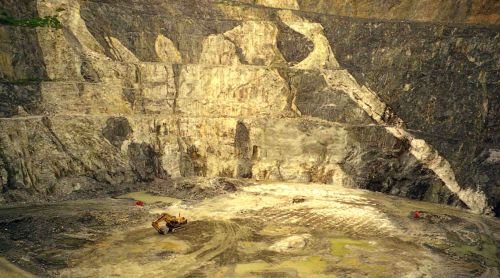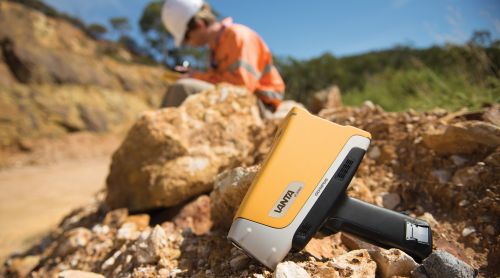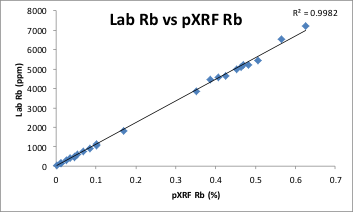Lithium Exploration in LCT Pegmatites Using Portable XRF
Portable X-ray fluorescence (pXRF) analyzers are useful tools that aid in the exploration and investigation of lithium-bearing mineral deposits. Current global lithium production is derived from two key deposit types: 1) lithium-bearing pegmatites and 2) lithium brines or salars, with global output divided roughly 50:50 from each source. Here we focus on lithium-bearing pegmatites and how to apply Vanta™ portable XRF analyzers to these styles of deposits.
 |  |
Figure 1. Left: the world-class Greenbushes Li-Ta-Sn LCT pegmatite in Western Australia. Right: a Vanta™ portable XRF analyzer is used for geochemical mineral exploration.
Exploration for LCT Pegmatites
Lithium-bearing pegmatites are plutonic rocks formed by the late-stage fractionation and emplacement of fertile, peraluminous granites. They are commonly referred to as lithium-caesium-tantalum (LCT) pegmatites due to the enrichment in the incompatible elements of lithium, caesium, tin, rubidium, and tantalum and are distinguished from other rare-element pegmatites, namely niobium-yttrium-fluorine (NYF), by this diagnostic suite of elements. LCT pegmatites are also generally enriched in fluxing components, including water, fluorine, phosphorus, and boron. This is evident in their unique geochemical and mineralogical makeup.
Mineralogically, LCT pegmatites are dominated by an assemblage of quartz, K-feldspar, albite, and muscovite. They are commonly zoned with the more evolved and fractioned phases, such as spodumene (Li), lepidolite (Li), petalite (Li), tantalite-columbite (Ta-Nb), cassiterite (Sn), apatite (P), beryl (Be), tourmaline (B), and garnets occurring within the inner core zones and margins.
Comparing Lab and Portable XRF Data from LCT Pegmatites
While direct analysis of lithium is impossible using pXRF due to X-ray physics limitations, the latest generation of instruments can be used effectively to identify a key suite of whole rock and associated pathfinder elements. This includes potassium (K), calcium (Ca), rubidium (Rb), strontium (Sr), yttrium (Y), niobium (Nb), tin (Sn), caesium (Cs), tantalum (Ta), antimony (Sb), tungsten (W), bismuth (Bi), arsenic (As), gallium (Ga), thallium (Tl), and the rare earth elements (REEs) of lanthanum (La) and cerium (Ce). Many of these correspond to Group 1 alkali metals and high-field-strength elements (HFSE) on the periodic table.
Work completed by Trueman and Cerny (1982) describes a number of correlations used to differentiate rare metalbearing pegmatites from barren pegmatites, including the use of K/Rb ratios, where Rb substitutes for K in micas and feldspar during late-stage crystallization. They noted that a K/Rb ratio of 160 indicates increasing fractionation, and ratios of 15 correlate to highly fractioned pegmatites often containing rare metal mineralization, particularly Ta, Nb, Be, Cs, and Li. This is illustrated in Figure 2, which contains sample data from an LCT pegmatite deposit in Southeast Asia, with good agreement between the lab and pXRF data for key elements.
 |  |
 |  |
 |  |
Figure 2. Lab and pXRF data on lab-pulps from an LCT pegmatite deposit, showing excellent agreement between (a) lab Rb vs. pXRF Rb; (b) lab Sn vs. pXRF Sn; (c) lab Li vs. Rb; (d) lab Li vs. pXRF Rb; (e) lab Li vs. pXRF K; and (f) lab Li vs. pXRF K/Rb. Data courtesy of Argo Metals Group from an LCT pegmatite project in Southeast Asia.
It must also be noted that, due to the extremely coarse-grained nature of pegmatites, good sample preparation and presentation is integral to obtaining reliable results. With this in mind, pXRF can be used to:
- Identify and assess granitic parent rock fertility with respect to the hosting potential of LCT pegmatites. Fertile granites exhibit elevated Rb, Cs, Sn, and Ta, as well as lower K/Rb ratios than typical granites.
- Differentiate rare metal-bearing pegmatites from barren, more typical pegmatites with granitic composition and to differentiate LCT-pegmatites from NYF-pegmatites.
- Act as a proxy for lithium grade, where a strong correlation exists with pathfinder elements (Rb in particular) and has been determined by a detailed orientation survey with sufficient quality laboratory data (shown in Figure 2).
- Directly analyze outcrop, surface soil samples, and drilling cuttings. In particular, Sn, Sb, and As, can be used effectively to map out surface anomalies where Li, Cs, K, and Rb have been mobilized and/or depleted.
- Analyze whole rock chemistry (Mg, Al, Si, K, Ca, and Fe) and immobile trace elements (such as Ti and Zr) for litho-geochemistry to determine deposit stratigraphy, alteration, and pegmatite zonation.

